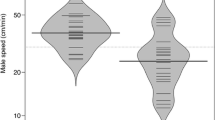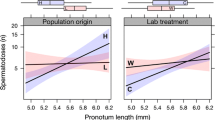Summary
Over five hundred adult longhorn milkweed beetles, Tetraopes tetraophthalmus, were individually marked and their copulatory success followed for one month in a pasture of Asclepias syriaca in northern Indiana, USA. Migration of beetles from the field site was greatest from areas of low population density. Dispersal was significantly greater for males experiencing low copulatory success; a similar but nonsignificant trend was observed for females. Large males, which displayed greater site tenacity than small males, copulated more frequently than small males because of their ability to displace small males from females. Both large and small males demonstrated a preference for large females in laboratory tests. Male preference in combination with aggressive displacement of small males results in size-assortative mating which was much stronger under conditions of high population density. It contributes to variance in male reproductive success since female size is known to be correlated with fecundity and offspring viability. Variance in copulatory success is similar for males and females, suggesting that both sexes experience similar intensities of sexual selection with respect to this component of reproductive success. Futhermore, comparison of this with other studies suggests that the intensity of sexual selection among males is positively correlated with the variance in body size which appears to be under both stabilizing and directional sexual selection in males but not in females.
Similar content being viewed by others
References
Charlesworth B (1984) The cost of phenotypic evolution. Paleobiol 10:319–327
Davis MA (1984) The flight and migration ecology of the red milkweed beetle (Tetraopes tetraophthalmus). Ecology 65:230–234
Johnson LK (1982) Sexual selection in a brentid weevil. Evolution 36:251–262
Low BS (1978) Environmental uncertainty and the parental strategies of marsupials and placentals. Am Nat 112:319–335
Mason LG (1964) Stabilizing selection for mating fitness in natural populations of Tetraopes. Evolution 18:492–497
McCauley DE (1979) Geographic variation in body size and its relation to the mating structure of Tetraopes populations. Heredity 42:143–148
McCauley DE (1982) The behavioral components of sexual selection in the milkweed beetle Tetraopes tetraophthalmus. Anim Behav 30:23–28
McCauley DE (1983) An estimate of the relative opportunities for natural and sexual selection in a population of milkweed beetles. Evolution 37:701–707
McCauley DE, Ott JR, Stine A, McGrath S (1981) Limited dispersal and its effect on population structure in the milkweed beetle Tetraopes tetraophthalmus. Oecologia (Berlin) 51:145–150
McLain DK (1982a) Density dependent sexual selection and positive phenotypic assortative mating in natural populations of the soldier beetle, Chauliognathus pennsylvanicus. Evolution 36:1227–1235
McLain DK (1982b) Behavioral and morphological correlates of male dominance and courtship persistence in the blister beetle Epicauta pennsylvanica (Coleoptera: Meloidae). Am Midl Nat 107:396–403
McLain DK (1984) Host plant density and territorial behavior of the seed bug, Neacoryphus bicrucis (Hemiptera: Lygaeidae). Behav Ecol Sociobiol 14:181–187
McLain DK (1985) Clinal variation in morphology and assortative mating in north Georgia populations of the soldier beetle, Chauliognathus pennsylvanicus. Biol J Linn Soc 25:105–117
McLain DK (1986) Null models and the intensity of sexual selection. Evol Theory 8:49–52
McLain, DK, Boromisa RD (1987) Stabilizing sexual selection and density dependent correlates of copulatory success in the ambush bug, Phymata wolffii (Hemiptera: Reduviidae). Am Midl Nat (in press)
Parker GA (1970) Sperm competition and its evolutionary consequences in the insects. Biol Rev 45:525–568
Price PW, Wilson MF (1976) Some consequences for a parasitic herbivore, the milkweed longhorn beetle, Tetraopes tetraophthalmus, of a host-plant shift from Asclepias syriaca to A. verticillata. Oecologia (Berlin) 25:331–340
Scheiring JF (1977) Stabilizing selection for size as related to mating fitness in Tetraopes (Coleoptera: Cerambycidae). Evolution 31:447–449
Schultz BB (1985) Levene's test for relative variation. Syst Zool 34:449–456
Smead JS, Alcock J (1985) Aggregation formation and assortative mating in two meloid beetles. Evolution 39:1123–1131
Sokal RR, Rohlf FJ (1981) Biometry. Freeman, San Francisco
Southwood TRE (1966) Ecological methods with particular reference to the study of insect populations. Methuen, London
Thornhill R, Alcock J (1983) The evolution of insect mating systems. Harvard University Press, Cambridge, Mass
Trivers RL (1972) Parental investment and sexual selection. In: Campbell, B (ed), Sexual selection and the descent of man. Aldine, Chicago, pp 136–179
Wade MJ, Arnold SJ (1984) On the measurement of natural and sexual selection: theory. Evolution 38:709–719
Wilson DS, Hedrick A (1982) Speciation and the economics of mate choice. Evol Theory 6:15–24
Author information
Authors and Affiliations
Rights and permissions
About this article
Cite this article
McLain, D.K., Boromisa, R.D. Male choice, fighting ability, assortative mating and the intensity of sexual selection in the milkweed longhorn beetle, Tetraopes tetraophthalmus (Coleoptera, Cerambycidae). Behav Ecol Sociobiol 20, 239–246 (1987). https://doi.org/10.1007/BF00292176
Received:
Accepted:
Issue Date:
DOI: https://doi.org/10.1007/BF00292176




